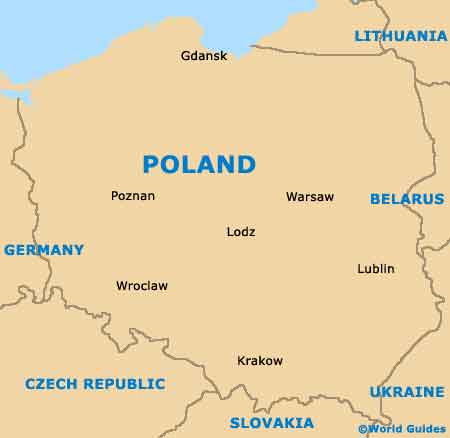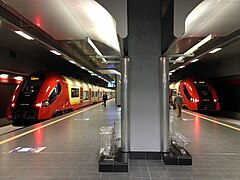What you need to know
WARSAW COUNTRY MAP

FLAG OF WARSAW

GOVERNMENT
MAYOR OF WARSAW
Hanna Gronkiewicz-Waltz
As the capital of Poland, Warsaw is the political centre of the country. All state agencies are located there, including the Polish Parliament, the Presidential Office and the Supreme Court. In the Polish parliament the city and the area are represented by 31 MPs (out of 460). Additionally, Warsaw elects two MEPs (Members of the European Parliament).
The Sejm is the lower house of the Polish parliament. The Sejm is made up of 460 deputies, or Poseł in Polish (literally 'Envoy'). It is elected by universal ballot and is presided over by a speaker called the Marshal of the Sejm (Marszałek Sejmu).
GEOGRAPHY
Warsaw is made of flat land, plains and occasional hills. Geographically situated in the central-eastern part of Poland, the city lies in the heart of the Masovian Plain.
Poland is conveniently close to other European countries like Russia, Lithuania, Belarus and Ukraine on the west, Germany and Czech to the east, Slovakia on the south and the Baltic Sea up north.
City Grounds
Warsaw is a relatively engineered city. When it was bombarded to the ground during WWII, the old historical structures were remade to its original design. The modern constructions came and skyscrapers were erected all over the city. The River Vistula runs north to south diagonally across Warsaw. Streets were cleverly planned to accommodate housing, commercial, natural and tourist districts.
POPULATION
Poland’s capital and largest city is Warsaw, located on the Vistula River. With a total population of 2,666,278 million people and a density of 1,635 inhabitants per square mile, Warsaw is not only the largest city in Poland, but also the 9th most populated city in the European Union. Warsaw’s nickname is the “Phoenix city” because it has survived so many wars throughout its past.
LANGUAGE
Poland's official language is Polish, with Warsaw residents speaking Polish as their first language and only some of the city's population being fluent in English, French or German. While tourist hotspots always have a ready number of locals with adequate English skills, it is advisable to take a phrasebook with you for taxi rides, ordering food and visiting out-the-way places. You will also find Poles who speak Russian, after being required to learn the language under Russian rule by law; however, as a form of patriotism, many Poles consider speaking Russian offensive.
CURRENCY
Poland uses the Zloty (PLN), with 1 Zloty divided into 100 groszy. Bank notes are available in denominations of 10, 20, 50, 100 and 200 Zloty, while coins are available in denominations of 1, 2 and 5 Zloty, and 1, 2, 5, 10, 20 and 50 groszy.
ATMs are available in many parts of Warsaw - ensure you inform your bank before travelling abroad, and be aware you may be charged for cash withdrawals. It is advisable to exchange some cash before arriving in Warsaw.
Warsaw - Notes and Coins

CLIMATE
Warsaw is generally a humid city. Snowy and cold during the winters when temperature ranges from -4°C and 6°C (25°F and 42°F); the summer scorches a warmer 9°C and 22°C (47°F and 73°F). Rainfall scatters all year round, but it mostly pours during July.
RELIGION
Throughout its existence, Warsaw has been a multi-cultural city. According to the 1901 census, out of 711,988 inhabitants 56.2{0bd0c231ec82858473630fc3cfd00e4eb3c514c49747a46033c87bb98098ad27} were Catholics, 35.7{0bd0c231ec82858473630fc3cfd00e4eb3c514c49747a46033c87bb98098ad27} Jews, 5{0bd0c231ec82858473630fc3cfd00e4eb3c514c49747a46033c87bb98098ad27} Greek orthodox Christians and 2.8{0bd0c231ec82858473630fc3cfd00e4eb3c514c49747a46033c87bb98098ad27} Protestants. Eight years later, in 1909, there were 281,754 Jews (36.9{0bd0c231ec82858473630fc3cfd00e4eb3c514c49747a46033c87bb98098ad27}), 18,189 Protestants (2.4{0bd0c231ec82858473630fc3cfd00e4eb3c514c49747a46033c87bb98098ad27}) and 2,818 Mariavites (0.4{0bd0c231ec82858473630fc3cfd00e4eb3c514c49747a46033c87bb98098ad27}).This led to construction of hundreds of places of religious worship in all parts of the town. Most of them were destroyed in the aftermath of the Warsaw Uprising of 1944. After the war, the new communist authorities of Poland discouraged church construction and only a small number were rebuilt.
ECONOMY
Warsaw contributes about 12{0bd0c231ec82858473630fc3cfd00e4eb3c514c49747a46033c87bb98098ad27} to Poland's total income. With a speeding upward GDP growth of 6.5{0bd0c231ec82858473630fc3cfd00e4eb3c514c49747a46033c87bb98098ad27}, the city is ranked the 35th most expensive city to live in, according to GaWC, in 2008.
Many global companies are building branches, offices and headquarters in Warsaw. With even less than 3{0bd0c231ec82858473630fc3cfd00e4eb3c514c49747a46033c87bb98098ad27} unemployment rate, the city is home to major universities, high-end malls, government seats, churches and some of Europe's tallest buildings. The charming blend of the city's Old Town, New Town and city central is a beautiful play for the tourists, who get to appreciate the rebuilt historical structures, along with the chic, colourful towers facilitating modern needs.
The industrial leg of the city comprises of electronics, high-tech mechanics and the fast growing food-processing industry. Only a number of major factories are still running in Warsaw, like a steel mill and an export car factory.
Warsaw Stock Exchange proves to be one of the most promising trading sectors in Europe, with more than 300 companies listed. Varied financial options like cash, derivatives or investments, are offered to market players and investors.
CULTURE
At first glance, Warsaw doesn't appear like an interesting destination compared to other European capitals since it was decimated during the war and rebuilt during communism. Thus, without a defined city centre, its cultural life is spread out across the city. And these hot spots are hard to find as many are located in courtyards, former factories, train ticket stations and dark backstreets. However, Warsaw has the largest cultural budget in the country, and there is more going on in 2011 then ever before. The City is working hard to be awarded the European Capital of Culture 2016 title. Warsaw has been shortlisted alongside Katowice, Lublin, Gdansk and Wroclaw and the winner will be announced in late June. Though Krakow may be considered Poland's "cultural capital," Warsaw has actually often eclipsed its southern relative in the arts. Two cultural heydays of Poland's capital stand above the rest: the years under the country's last King, Stanislaus Poniatowski as well as the inter-war period, when the city was dubbed the Paris of the East. Now, after a challenging twentieth century, Warsaw is back and more vibrant than ever! Festivals, cultural institutes, museums, galleries, theatres, all that you can handle...
TRANSPORT
Warsaw has seen major infrastructural changes over the past few years amidst increased foreign investment, economic growth and EU funding. The city has a much improved infrastructure with new roads, flyovers, bridges, etc.[128]
Warsaw lacks a good ring road system and most traffic goes directly through the city centre, leading to the third highest level of congestion in continental Europe.[129] The Warsaw ring road has been planned to consist of three express roads: S2, S8 and S17. Currently parts of S2 and S8 are open, with the remaining construction to be finished by 2019.
Thanks to the A2 motorway stretching west from Warsaw, which opened in June 2012, the city now has a direct motorway connection with Łódź, Poznań and ultimately with Berlin.
The city has two international airports: Warsaw Chopin Airport, located just 10 kilometres (6.2 mi) from the city centre, and Warsaw-Modlin Airport, located 35 kilometres (22 mi) to the north, opened in July 2012. With around 100 international and domestic flights a day and with 11,206,700 passengers served in 2015, Warsaw Frédéric Chopin Airport is by far the biggest airport in Poland[130] and it has also been called "the most important and largest airport in Central Europe"
Public transport in Warsaw includes buses, trams (streetcars), Metro, light rail Warszawska Kolej Dojazdowa line, urban railway Szybka Kolej Miejska, regional rail Koleje Mazowieckie (Mazovian Railways),[132] and bicycle sharing systems (Veturilo). The buses, trams, urban railway and Metro are managed by Zarząd Transportu Miejskiego (ZTM, the Warsaw Municipal Transport Authority).
The regional rail and light rail is operated by Polish State Railways (PKP). There are also some suburban bus lines run by private operators.[133] Bus service covers the entire city, with approximately 170 routes totalling about 2,603 kilometres (1,617 mi), and with some 1,600 vehicles.
Currently, the Tramwaje Warszawskie (Warsaw Trams) company runs 863 cars on over 240 kilometres (150 mi) of tracks. Twenty-odd lines run across the city with additional lines opened on special occasions (such as All Saints' Day).
The first section of the Warsaw Metro was opened in 1995 initially with a total of 11 stations.[134] It now has 21 stations running a distance of approximately 23 km (14 mi).[135] Initially, all of the trains were Russian built. In 1998, 108 new carriages were ordered from Alstom.[134] The second line running east-west will be about 31 km (19 mi). The central section is 6 km (4 mi) long with seven stations.,[134] opened on 8 March 2015.
The main railway station is Warszawa Centralna serving both domestic traffic to almost every major city in Poland, and international connections. There are also five other major railway stations and a number of smaller suburban stations.
PUBLIC TRANSPORT IN WARSAW
Metro Line 1, Wilson Square station

Metro Line 2, Nowy Świat-Uniwersytet station
Bus
Tram Car

Fast City Rail trains, Chopin Airport station
Koleje Mazowieckie train, Stadium station
Veturilo bicycles station

ATTRACTIONS IN WARSAW

Warsaw is the sprawling capital of Poland. Its widely varied architecture reflects the city's long, turbulent history, from Gothic churches and neoclassical palaces to Soviet-era blocks and modern skyscrapers. As Poland’s cultural hub, Warsaw has a thriving nightlife and music scene, both classical and underground. After near-total destruction in WWII, Warsaw’s old town was faithfully restored to its pre-war appearance.
BEACHES
The Beaches in Warsaw began to be popular with sunbathing during the interwar period of the 20th century. In around the Miedzeszyński Embankment (Wał Miedzeszyński) functioned a popular beach area, this included the Beach of the Kozłowski Brothers (Plaża Braci Kozłowskich) and the Poniatówka urban beach - both of which had wooden pavilions and changing rooms. The modern functional beaches in Warsaw were featured in National Geographic's Top Urban Beaches in the World. The modern twenty first century functioning beaches in Warsaw are (from north to south: Białołęka Beach (plaża na Białołęce) in the vicinity of the Maria Skłodowska-Curie Bridge. Żoliborz Beach(plaża na Żoliborzu) in the vicinity of the Olympic Centre (Centrum Olimpijskie). Beach by the music club La Playa by the Wybrzeże Helskie, connected by a ferry crossing to Podzamcze. Stadium Beach(plaża Stadion) in the vicinity of the National Stadium, connected by a ferry with the Wybrzeże Kościuszkowskie, with a built pavilion located by the beach built by the City of Warsaw. Beach by the Kryniczna Street is located close by the Łazienkowska Thoroughfare, the beach functions for over 70–80 years in the same place.The beach is connected by a ferry crossing with the Cypel Czerniakowski. Wilanów Beach(plaża Wilanów) is located by the Aleja Wilanowska. In 2014, due to the increasing popularity of urban beaches the City of Warsaw launched a night tram line from the Poniatowski Bridge.
In 2014, due to the increasing popularity of urban beaches the City of Warsaw launched a night tram line from the Poniatowski Bridge.
Vistula River -Poniatówka beach

The beach on the right side of Vistula river is something unique for the European capital. In the centre of the city we have a wild and wide beach. You can have a bonfire there, sunbathe, or play volleyball. Along the entire coast there is also a bike route and you can have a nice little trip riding down there.
You can observe some wild animals at the Vistula river. I’ve seen otters and deers just across the city centre. My friends have even seen boars and elk there!
Poniatówka beach is a part of the coast just at the Poniatowski bridge. This place, according to Facebook, was one of the 10 most popular spots in Europe. It’s the place with the biggest amount of check-ins in 2013 on our continent.
On a summer night this place is one of the hottest party places. There are also two beach bars there – Temat Rzeka and Plażowa, that organise some events, as well as usually a couple of food-trucks.











